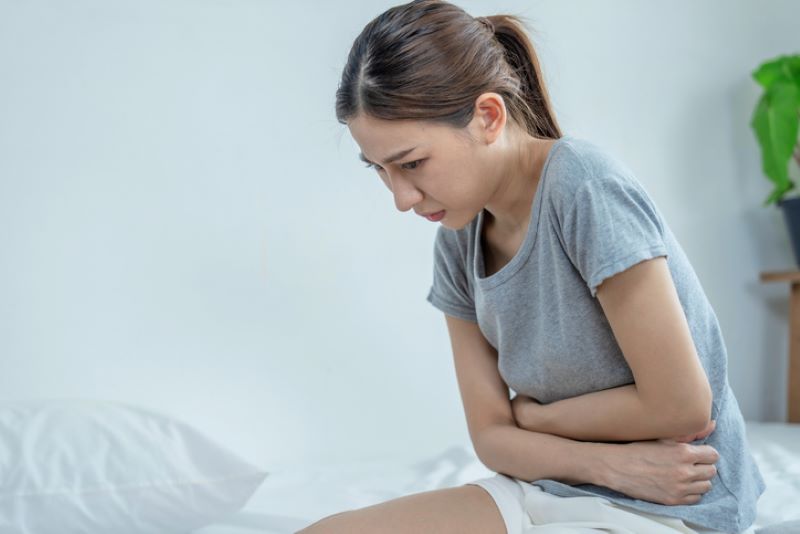How Can I Manage PMS and Its Impact on My Sexual Well-Being?

Premenstrual syndrome (PMS) is a common condition that affects many individuals with uteruses during their menstrual cycle. PMS is known for its physical symptoms such as bloating, breast tenderness, headaches, and cramps, as well as its emotional symptoms including mood swings, irritability, anxiety, and feelings of sadness. Nevertheless, its impact on sexual well-being is often overlooked.
Several studies have shown that PMS can negatively impact sexual well-being, potentially decreasing one’s interest in sex and their sexual satisfaction. Fortunately, there are ways to manage these challenges if you are interested in mitigating the negative effects PMS may have on your sexual health.
PMS may impact a person’s sexual well-being in the following ways:
Physical discomfort: PMS symptoms like bloating, breast tenderness, and cramps can make sexual activity uncomfortable or painful for some people. As such, many individuals may choose to abstain from sexual activity during this time to avoid discomfort.
Reduced libido: The hormonal fluctuations and emotional symptoms associated with PMS can contribute to a decreased sex drive.
Body image issues: Some individuals may experience body image concerns during PMS due to bloating and weight gain. These concerns can make them feel less confident and less interested in sexual activity.
For individuals who are interested in managing their PMS symptoms and their impact on sexual well-being, there are a few tips that may be helpful.
- Track your symptoms: Start by keeping a PMS diary to identify patterns and triggers of symptoms. Understanding when PMS is likely to occur can help you plan for potential challenges in your sexual health.
- Communicate with your partner: Open and honest communication is key. Let your partner know about your PMS symptoms and how they might affect your sexual desire and comfort. Discuss ways you can both support each other during this time.
- Explore alternative forms of intimacy: If sexual activity is uncomfortable during PMS, consider other forms of intimacy that can help you stay connected with your partner. This might include cuddling, kissing, or simply spending quality time together.
- Manage physical symptoms: Over-the-counter pain relievers can help alleviate cramps and headaches. You can also try heat therapy with a hot water bottle or warm bath to ease muscle tension and discomfort.
- Practice self-care: Prioritize self-care during PMS by getting enough rest, maintaining a balanced diet, and engaging in stress-reducing activities like yoga or meditation. These practices can help mitigate emotional symptoms and improve your overall well-being.
- Seek professional help: If PMS symptoms severely impact your daily life and sexual well-being, consult a healthcare provider. They can help you explore treatment options such as medication, therapy, or lifestyle changes to manage PMS effectively.
PMS can indeed affect your sexual well-being, but it is important to remember that you’re not alone in facing these challenges. By understanding your symptoms, communicating with your partner, and exploring ways to manage physical and emotional discomfort, you can navigate PMS more effectively and maintain a healthy and satisfying sexual relationship.
For more information on this topic, please read these publications from the ISSM Journals: The Journal of Sexual Medicine, Sexual Medicine Reviews, and Sexual Medicine Open Access:
Premenstrual dysphoric disorder and sexual function: a narrative review
Sexual Satisfaction in Females with Premenstrual Symptoms
References:
Nowosielski, K., Drosdzol, A., Skrzypulec, V., & Plinta, R. (2010). Sexual satisfaction in females with premenstrual symptoms. The Journal of Sexual Medicine, 7(11), 3589–3597. https://doi.org/10.1111/j.1743-6109.2010.01927.x
Office on Women’s Health. (2021, February 22). Premenstrual syndrome (PMS). https://www.womenshealth.gov/menstrual-cycle/premenstrual-syndrome
You may also be interested in...
Other Popular Articles

What Is Jelqing, and Does It Actually Work?
The term “jelqing” refers to a set of penis stretching exercises that some believe can make the penis bigger. Although the practice has gained attention and popularity in blogs and internet forums in recent years, there is no scientific evidence that it is an effective way to permanently increase the size of one’s penis. In fact, in some cases, jelqing may actually cause damage to the penis, so it is a good idea to get all the facts before setting off to try it.

What Is the Average Penis Size?
If you have ever wondered how your penis compares to others in terms of size, you are not alone. Many men are curious to know how their penises stack up compared to the average. Unfortunately, general curiosity can sometimes give way to full-on obsession and anxiety about penis size. This can be an unhealthy and often unnecessary fixation, especially because most men who think their penises are too small have perfectly normal-sized penises.

What Is Sensate Focus and How Does It Work?
Sensate focus is a technique used to improve intimacy and communication between partners around sex, reduce sexual performance anxiety, and shift away from ingrained, goal-oriented sexual patterns that may not be serving a couple.

Can Sex Reduce Menstrual Cramps?
The SMSNA periodically receives and publishes ‘guest editorials.’ The current article was submitted by Mia Barnes, a freelance writer and researcher who specializes in women's health, wellness, and healthy living. She is the Founder and Editor-in-Chief of Body+Mind Magazine.
Having sex while you experience menstrual cramps is healthy and can provide significant benefits. While it might not be the first activity that comes to mind when your PMS or period cramping begins, many people enjoy sex to reduce menstrual cramps, experience increased pleasure and benefit from other advantages. Learn more about having sex while menstrual cramps are happening and how it can help your body.

How Long Does It Take the Average Man to Ejaculate?
On average, it takes a man between 5 to 7 minutes to orgasm and ejaculate during sexual intercourse.

The Effect of Regular Aerobic Exercise on Erectile Function
Erectile dysfunction (ED) is the inability to achieve or maintain an erection sufficient for satisfactory sexual activity. As men get older, their erectile functioning may naturally decline due to changes in testosterone levels, cardiovascular functioning, and the potential development of other chronic medical conditions that become more common with age.
You are prohibited from using or uploading content you accessed through this website into external applications, bots, software, or websites, including those using artificial intelligence technologies and infrastructure, including deep learning, machine learning and large language models and generative AI.

